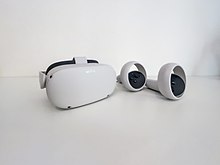
A virtual reality headset (or VR headset) is a head-mounted device that uses 3D near-eye displays and positional tracking to provide a virtual reality environment for the user. VR headsets are widely used with VR video games, but they are also used in other applications, including simulators and trainers. VR headsets typically include a stereoscopic display (providing separate images for each eye), stereo sound, and sensors like accelerometers and gyroscopes for tracking the pose of the user's head to match the orientation of the virtual camera with the user's eye positions in the real world.[1]
VR headsets typically use at least one MEMS IMU for three degrees of freedom (3DOF) motion tracking, and optionally more tracking technology for six degrees of freedom (6DOF) motion tracking. 6DOF devices typically use a sensor fusion algorithm to merge the data from the IMU and any other tracking sources, typically either one or more external sensors, or "inside-out" tracking using outward facing cameras embedded in the headset. The sensor fusion algorithms that are used are often variants of a Kalman filter. VR headsets can support motion controllers, which similarly combine inputs from accelerometers and gyroscopes with the headset's motion tracking system.
Most headsets are reliant on a personal computer to operate. Some "standalone" headsets are based on a mobile operating system and smartphone-like hardware, allowing VR apps to run directly on the device, while also allowing VR applications to be streamed from a PC over a USB or Wi-Fi connection. Virtual reality headsets and viewers have also been designed for smartphones, where the device's screen is viewed through lenses acting as a stereoscope, rather than using dedicated internal displays.
- ^ Kuchera, Ben (15 January 2016). "The complete guide to virtual reality in 2016 (so far)". Polygon. Archived from the original on 4 March 2016. Retrieved 1 March 2016.